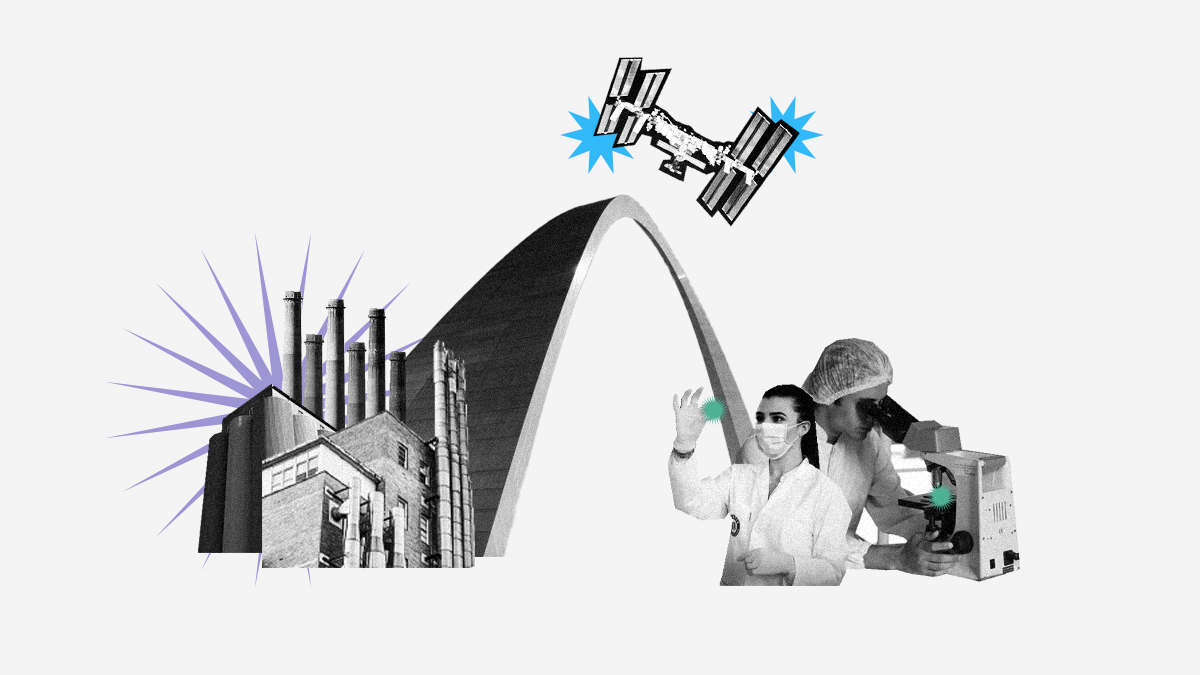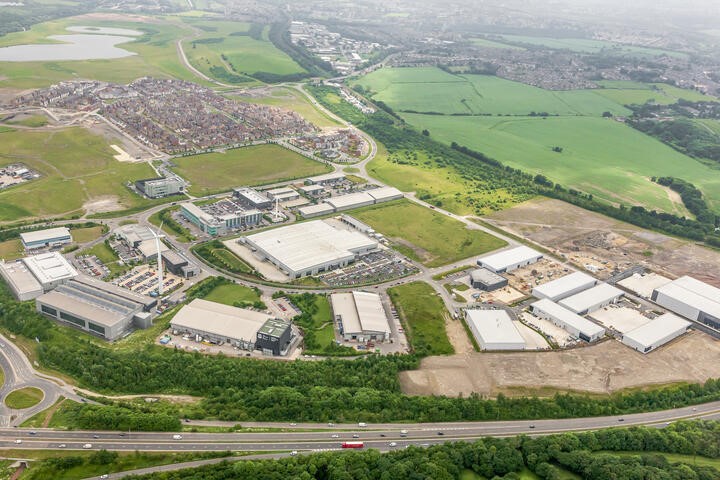
The圣路易斯技术三角联盟will receive approximately $25 million to support the region’s advanced manufacturing cluster – which will support and grow the existing biosciences and geospatial clusters. One of their primary projects is the Advanced Manufacturing Innovation Center (AMIC), which will be the hub of an inclusive ecosystem and bring investment to a historically excluded area of STL.
Tracy Henke is the Chief Policy Officer/President of ChamberSTL withGreater St. Louis Inc。, lead of the region’s Build Back Better Coalition. GSL was founded on January 1, 2021 as a result of combining the strengths of five legacy civic organizations into one with a unified focus around a common vision and strategy for fostering inclusive economic growth. Ben Johnson is Senior Vice President, Programs atBiostl。自2001年以来,BioStl为圣路易斯Biosciences创新经济奠定了基础,并利用了该地区的医学和植物科学优势的全面变革计划。
这次采访是FAS系列的一部分Unleashing Regional Innovation我们与领导者交谈,建立了下一波创新的集群和ecosystems在美国各地的社区中。我们的目标是聚焦他们的工作,并以身作则帮助其他社区学习。我们的第一轮采访是与Build Back Better Regional Challengerun by the Economic Development Administration as part of the American Rescue Plan.
瑞安·布斯卡利亚(Ryan Buscaglia):您能告诉我们您的联盟是如何汇聚在一起的以及组织之间合作伙伴关系的历史吗?您是否在EDA宣布其流程之前就研究了该项目的元素?
Tracy Henke:我们提案中心的整个概念起源于2015年。一些劳动力培训和与创新和企业家精神有关的项目已经在进行。但是他们正在分开进行。圣路易斯科技三角形和合作伙伴通过确定可以建立和利用的协同作用来汇聚在一起。这项[重建更好的区域挑战]是一个机会,可以通过联邦资金的支持加速这项工作,以确保我们可以团结而不是孤立地将它们凝聚在一起,并将它们更加凝聚在一起。
So, Ben, on the Bio side that you work on, had you been working on individual projects related to advancing the bioeconomy in St. Louis, which maybe hadn’t had as much connection to the other two legs of the triangle before this partnership came up?
Ben Johnson:I would echo Tracy in that this was an opportunity to grow existing, and find new, synergies across the industry cluster. For the biosciences, over 20 years in St. Louis, we’ve been working as a coalition of academic institutions, corporate partners, entrepreneurs, support organizations, philanthropy and civic organizations, to build our bioscience economy. With the success of that collaboration in building innovation infrastructure, we now feel like we’re just at the starting line of realizing the economic potential in some respects. These were existing partnerships and projects and collaborations that were in the works. In some ways, Tracy and her organization gave us a bit of a framework to knit that together with other emerging clusters in a way that some of the other clusters hadn’t really been positioned to organize in the past. I think a critical piece there is that we didn’t come together exclusively for the purposes of ‘here’s Build Back Better, let’s react to it.’ We had a foundation, we had coalition partnerships. We were able to come together around an organized thesis that really drives inclusive growth for the region. From there, projects knit together well. It wasn’t like, ‘Okay, here’s the NOFO. Let’s figure out what exists in the world.’ There was an existing framework for that discussion, including the STL 2030 Jobs Plan, stewarded through Tracy and Greater St. Louis Inc.
您能否谈谈为什么您决定专注于项目中的三个不同的领域(高级制造,地理空间和生物科学)?
Tracy:Understand that while it is the St. Louis Tech Triangle, the driver of our submission is advanced manufacturing. Advanced manufacturing supports biosciences, it supports geospatial and it leverages the history and existing strength of our region. Metro St. Louis has always been a leader in manufacturing and so that question, ‘why focus on all three?’ It’s a focus on advanced manufacturing that supports our biosciences, energy and our geospatial, and more. Also, we call it the tech triangle because when you look at an overview map of the region, you can literally create a triangle that links the placemaking hubs of the three clusters.
发展先进的制造集群支持我们现有的生物科学和地理空间活动,但也有助于成长并进一步发展,例如我们的航空航天和其他可能存在的机会,这利用了我们在该地区的过去和现在历史。
随着所有这些不同的项目正在进行,哪个联盟实际上领导着写作和提交申请?
Tracy:大圣路易斯公司做到了。为什么要大圣路易斯?部分是因为我们不是这些程序中的任何一个。我们是一个召集人,我们是一个与所有人合作的实体。希望他们都将GSL视为这项工作的合作伙伴。而且,由于您不能有20位作家,所以效果不佳。如果您有20个人进行这些采访,并且尝试将其放在一份凝聚力的文件中,那么您有20种不同的声音。因此,对于总体叙述,它需要以一种声音来使人们有意义。我们分享了它,并确保合作伙伴提供了反馈。我们可以通过EDA对我们的页码,许多要求等对我们的限制进行合并。各个合作伙伴写下了他们的个人提交; it doesn’t mean partners didn’t provide edits and guidance, and I did as well to ensure linkage with the overarching narrative, but they all wrote their own. We met on a regular basis, but there always has to be one person with the pen.
I’m glad you took the pen for St. Louis! Could you talk a bit about the Advanced Manufacturing Innovation Center (AMIC-STL) and why that is the hub of this proposal?
Tracy:The Advanced Manufacturing Innovation Center, which is referred to as AMIC-STL, was identified in 2015. The St. Louis Economic Development Partnership is a partner in our specific submission, not just the overarching narrative, but our specific submission on cluster growth. They received a grant back in 2014, I believe, when it looked like there was going to be significant downsizing in the aerospace industry here in the St. Louis metro, specifically Boeing. And so that’s when a defense readjustment grant was provided to help the region think about what does this region need to do, how do all those people get trained for other employment, and they looked at once again, this region’s strength in manufacturing.
AMICSTL is modeled off of the在英国谢菲尔德举行的AMRC。英格兰谢菲尔德的先进制造研究中心最初是一个由波音资助的实体。欧洲还有其他制造中心,我相信日本现在还有一个制造中心,它们都有些不同。但是,我们认为,以及我们在美国在这里研究的内容,我们在美国没有什么。先进的制造创新中心将是进行研发的机会。这将是进行原型制作和小批量制造的机会,也是创建我们称为不同空间垂直行业的机会。因此,航空航天垂直,生物科学垂直,垂直储能。它不仅会带来假设,航空航天和波音等主要实体,而且还带来了所有其他供应商,所有供应波音的实体以及波音公司所做的一切以及随之而来的研究。通过共同融合,它允许对思想进行交叉授粉,并跨授粉如何以其他方式使用事物。

英格兰谢菲尔德的先进制造研究中心最初是一个由波音资助的实体。
所以可能被用作与科技有关的东西nology on a drone to look under the canopy of trees might have some technology applicable to the healthcare space. Or researchers might be able to take something that they learned from the development of a specific technology and apply it in a completely different field. Having these researchers and developers and the ability to prototype etc, allows for cross pollination of ideas and that growth, which then spurs additional development and additional growth.
If you look at what happened in AMRC and Sheffield, they started with a handful of R&D individuals, they now have over 500. And they now have over 400 units of housing built. They started with one building, they now have multiple buildings.
Ben:Another point I think that was critical, particularly for our regional strategy and commitments but also for Build Back Better and EDA is the physical geographic location in a significantly disinvested historically excluded community. It really gives an opportunity to bring some of this new manufacturing innovation, bridging the biosciences and geospatial, as sort of a beachhead into a neighborhood and community where that type of investment has not occurred in a significant amount of years.
Tracy:When you look at the history of St. Louis, and you look at how communities were built up, a lot of them were built up within the urban core around manufacturing. Unfortunately, we lost a lot of that and then saw out-flight. Even early in 2015-2016 with the conversation about the establishment of this Advanced Manufacturing Innovation Center, they talked then about how its location should be in a historically disinvested community. And so this is a strategic location in the heart of the city where the land currently exists, right next to a technical school and in close location to multiple education institutions as well that can help on the workforce side, strategically located near NGA West, near our cortex and biosciences partners, as well as surrounded by other workforce partners.
Recognizing that this is a tough challenge, how are you making sure that AMIC-STL has a constructive and growth minded and equitable result for the community rather than continuing a trend of either pushing people out of homes / businesses or making it difficult for existing residents and existing community members to stay there?
Tracy:GSL几乎每周都会带来我们的Amic-STL合作伙伴,我们的城市合作伙伴以及我们的邻里合作伙伴,那里的Amic-STL将位于桌面上。
Once again, this is purposeful on its location. There is nothing currently on the site. Most of the surrounding community, quite honestly, has suffered from disinvestment. There are vacant homes and boarded up buildings because of the outflight and more. And so we are working to ensure AMICSTL, being that centerpiece, sort of like AMRC and Sheffield, will create this domino effect. But to do that, we also have to make sure that partners are at the table. In addition we must have community engagement and will use BBBRC funding to help with this. We’re also drafting an RFP on establishing the baseline of metrics as it relates to the manufacturing ecosystem in the region, as well as the spokes of that and how far they reach.
We’re looking at this holistically. We’re not just looking at building a building.
Also, our workforce partners are looking at what gaps exist in workforce training, and not creating new workforce programs necessarily, but how do our existing workforce entities fill those gaps. We’re looking at this holistically. We’re not just looking at building a building. I think that’s the important thing.
How will St. Louis look different in ten years if you’re successful in doing what you proposed?
Tracy:十年来:建立了AMIC,多米诺骨牌开始导致增长。我们的劳动力培训,我们的创新企业家精神,我们的社区参与,我们的集群成长正在起作用。我可以说这将在一夜之间吗?不,我不能。这很容易吗?不它不是。十年来,我们希望我们能看到进步吗?是的。我们能说,我们希望继续看到友善在垂直方面增长,并带有对不同领域和线条的好处?是的。 We are doing this deliberately and with intention to ensure a higher probability of success.
Ben:Ten years from now, I believe through Build Back Better and the collaboration to form it—with AMIC as its embodiment—will be a longitudinal and generational model, even if it is a model still in progress. It will be a model for how we do intentional, inclusive economic growth with increased permeability between innovation districts and underserved neighborhoods. A new model for STL and beyond for lessons learned and successes. Ten years, we will still be getting better and continuously improving in that work, but AMIC will be a significant mile post in that journey of St. Louis doing things differently.
The St. Louis Tech Triangle coalition will receive approximately $25 million to support the region’s advanced manufacturing cluster – which will support and grow the existing biosciences and geospatial clusters.
BRIDG is not-for-profit public-private partnership located in Osceola County, Florida providing semiconductor R&D and production capabilities to industry and government. Here’s how their region innovates.
生态系统不仅仅是生物学家。这是企业家和政策制定者应将创新社区视为生态系统的方式和为什么。
Interagency Community Investment Committee agencies should partner with the Small Business Administration to use their existing authority and infrastructure to pilot a secondary market for their securitized debt instruments.